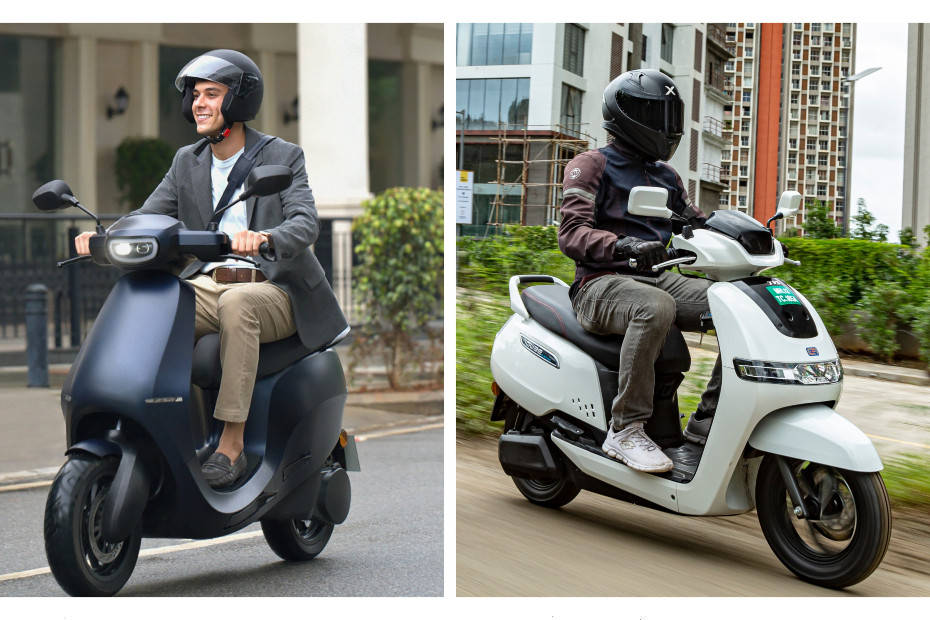Ola Electric S1 vs TVS iQube Electric: Photo Comparison
Modified On Aug 18, 2021 05:21 PM By Manaal Mahatmefor Ola S1
- 9070 Views
Confused between Ola Electric S1 and the first TVS e-scooter? A closer look at the two can help

A couple of months ago, TVS announced its plans to launch the iQube Electric in 20 cities by March 2022, and even signed an MoU with Convergence Energy Services to set up public charging infrastructure. The revisions in the FAME-II subsidy followed, making the e-scooter a tad bit more affordable.
And then there was the launch of the Ola Electric S1, which is not only slightly easier on your wallet but it will also be available in 1000+ cities. Furthermore, Ola Electric’s ambitious charging infrastructure plans make it all the more tempting.
Do you find yourself sitting on the fence between these two? Well, we bring you a photo comparo of the two to help you decide. Read on:
Design:


The Ola Electric scooter is based on the Etergo AppScooter, and it flaunts a typical European design. We’re talking about smooth, flowing lines, the headlight, and the single-sided front fork -- elements that easily make it stand out in a crowd. TVS, on the other hand, hasn’t gone overboard with futuristic styling, and has stuck to the conventional scooter design. Though the e-scooter has unique elements like the backlit logo, it can still easily pass off as a regular ICE scooter.
- How To Buy The Ola S1, S1 Pro Electric Scooters?
- Ola S1 Electric Scooter: Colours Explained
- EXCLUSIVE: 2021 Yamaha Fascino 125 Hybrid: Road Test Review
Headlight:


The dual LED headlight with the LED surround DRL is perhaps the most distinctive element in the Ola Electric S1. Complementing it are the neat LED indicators integrated into the bodywork. The iQube Electric also uses an LED setup, and contrary to its beefy bodywork, gets a sleek headlight flanked by indicators.
Console:


Both e-scooters get massive TFT instrument consoles. Though TVS hasn’t compromised on any aspect (and has offered bluetooth connectivity, turn-by-turn navigation, and call alert), it falls short compared to Ola's system. Not only does the Ola Electric S1 get the aforementioned features, but it also takes things up a notch with different themes (Moods, in Ola’s lingo), multiple profiles, and even in-built sound (to keep the ambient traffic aware). How fancy is that?
Motor:


Ola Electric’s mid-mounted motor produces 8.5kW of peak power and 5.5kW of continuous power. Its torque figures stand at 58Nm. TVS, on the other hand, has used a 3kW hub-mounted motor with a peak power output of 4.4kW and a claimed torque of 140Nm. This propels the TVS to a claimed top speed of 78kmph, which is still 12kmph shy of the 90kmph claimed top speed of the Ola S1.
Battery & Charging Time:




Ola’s claimed range of 121km is respectable, considering TVS’s e-scooter only offers 75km from its three lithium-ion battery packs.
Suspension:


Ola Electric has equipped the S1 with a single telescopic fork and a monoshock, which significantly add to the visual appeal of the scooter. Meanwhile, TVS has borrowed the telescopic fork from Jupiter's tried-and-tested formula. At the rear, dual shock absorbers have been used.
Braking:


Ola Electric’s braking hardware comprises a 220mm disc up front and a 180mm disc at the rear, aided by a combined braking system. Just like its suspension, the TVS iQube Electric relies on its ICE sibling for the braking setup, consisting of a 220mm disc at the front and a 130mm drum brake at the rear.
Final Call:
Though the TVS iQube Electric isn’t a letdown by any means, the arrival of the Ola Electric S1 has definitely posed a threat. Not only does the TVS fall short in performance but also in terms of availability. That said, Ola Electric has yet to deliver on its promise of catering to 1000 cities from October onwards.
